Sohrevard in the North-West Iranian province of Zanjan is the birth place of the Iranin Sufi mystic and philosopher Shihabuddin Yahya Suhrawardi. In March 2019 my dream came true, and I visited this place together with my Swiss friends Daniela and Dieter.

Already in 2007, when I began to study the Iranian mystic and philosopher Shihabuddin Yahya Suhrawardi, I felt the wish to visit once his birth town Sohrevard in Iran. Even if I could not find this place, which has 8000 inhabitants, at any of the available maps at this time. I only knew, that it had to be somewhere in the South-West of the town Zanjan. Eventually I discovered it on an old map in a book, and later also via Google Maps.
But in 2007 the conservative president Mahmoud Ahmadinejad ruled over Iran in service of the Mullahs. The political atmosphere und the conditions for individual tourists seemed not very attractive to me. So I decided to travel first to Suhrawardi's tomb in Aleppo, Syria (see travel report “In the Footsteps of the Shaykh al-Ishraq”).
In 2013 the more moderate Hassan Rouhani followed Ahmadinejad as president of Iran. In 2015 the nuclear deal between Iran, the USA, the EU, Russia and China was negotiated. And Iran began to welcome foreign tourists, especially from Europe. In a first step I joined a group of European sufis who traveled to South (Shiraz, Persepolis) and Central Iran (Yazd, Isfahan). After all I knew that Suhrawardi had studied logic at Zahir al-Din al-Wari in Isfahan, which was the most important university town of Iran during the 12th century.
Together with a girl friend I walked along the Zayandeh river in Isfahan, until we came to the oldest bridge across the river, the Pol-e Shahrestan, whose foundation was already built during the Sassanid aera. It seemed likely that also Suhawardi hat put his steps on it time and again. By the way, the Zayandeh river is now reduced to some tiny lakes in the dry river bed in Isfahan, due to increasing aridity and withdrawal of water for agriculture.
Pol-e Shahrestan, Isfahan
The openness and friendliness of the Iranian people during this journey impressed me so deeply, that I decided to plan my own journey to Iran together with two girl friends. I created two travel itineraries – one for the North West, with a side trip to Sohrevard. And another one along the railway line from Tehran to Mashhad, in the province of Khorasan in the North East. My two friends pleaded for Khorasan, which had an important role for the development of Sufism in the Middle Ages. And it took two more years, until I traveled to the North West in 2019, together with my Swiss friends Daniela and Dieter.
On the evening of 14th April 2019 I finally reach my goal – traveling by train from Tehran to Zanjan. The hilly landscape is bathed in enchanting evening light.
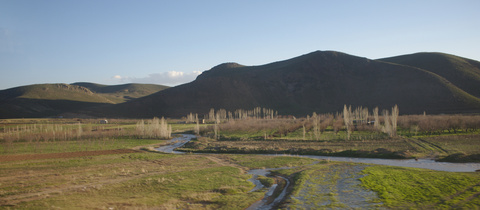
Landscape at Zanjan, NW-Iran
Hotel Dadamaan in Zanjan
The fruit trees around Zanjan are already blossoming. We stay at hotel Dadamaan, a traditional Persian mansion with a refreshing pool in the yard, and an open view to the marvelous starry sky at night. When we asked the hotel manager to organize a taxi to Sohrevard for the next day, he seemed astounded, "What do you seek there? There is nothing, absolutely nothing to see. Not even a bust of Suhrawardi, but we have one here, in Zanjan." But we persisted on our plan.
Next morning we depart after a marvelous breakfast buffet. First to Soltaniyeh. In the 14th century the Mongol Sultan Muhammad Oljeity Khudabanda had built a huge dome designated as tomb for Imam Ali and Imam Hossein. But then Shiite clerics opposed his plans, and the frustrated Oljeity, who had converted from Sunnism to Shiism, became Sunni again and decided to be buried himself in this dome. Today the building, which was one of the biggest in its time, is a World Heritage site.
Oljeitu Mausoleum
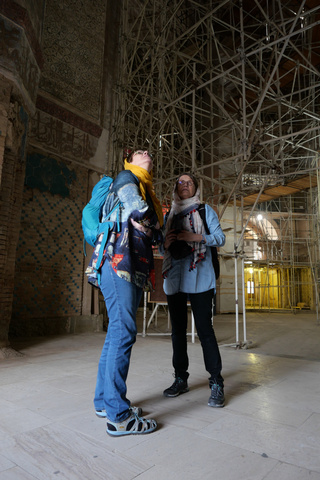
Daniela and Ingrid in the Mausoleum
We are fascinated by the huge dome, the inexhaustible variety of ornaments and the magnificent view from the gallery of the building down to the town of Soltaniyeh and the mountain ridge. Somewhere behind it lies Suhrawardi's birth place.
View from the gallery of the Mausoleum on the village of Soltaniyeh
But it takes another one and a half hour, until we reach the main goal of this day. After passing through the town Qeydar, our driver obviously has no clue how to drive further. He speaks only Farsi, and he asks several time for the way and takes some wrong side roads, until two moped drivers drive in front of us to lead us to the right junction.
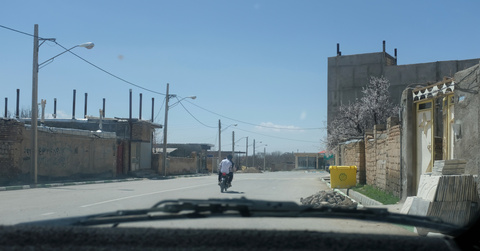
Our two guides on their moped
Fruitful fields along the road

First view of Sohrevard
I had expected, that we would stay there for one hour or two, walking through the small town. And maybe ascending the hill behind it, to find a place to meditate and attune to the great Sufi master. But it comes otherwise. When we enter Sohrevard, our driver asks another time for directions.
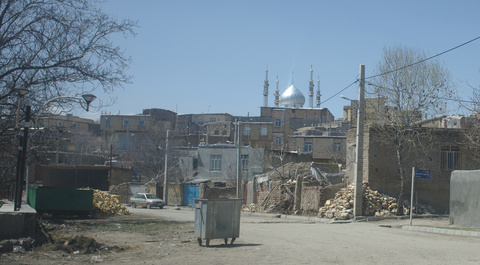
Entering Sohrevard
Then he heads towards a certain house, which seems to be a kind of school. We learn, that it is a creative center for children and adults. A black clothed woman welcomes us and tells us non-verbally to stay there and wait.
We have no idea, where we are, and for whom we should wait. But then the English teacher of the town arrives, Mahmood Mohammadi. And we come to know that we are at the very place, where Suhrawardi once was born and grew up. There is even a part of the stone wall of his former birth house preserved.
Here stood once Suhrawardi's birth house
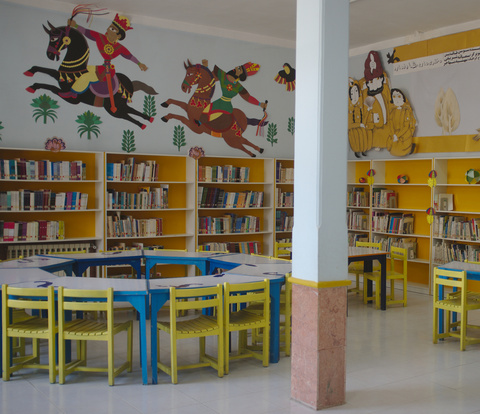
Today it hosts a creativity center for children and adults
Old stonewall from the original house
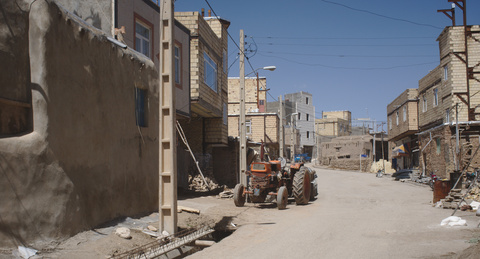
Road in front of Suhrawardi's former birth house
After a warm welcome Mahmood drives us to the springs of the town. These are of enormous importance for the small community, both as drinking water supply for the people and as irrigation for the fields and fruit trees. The teacher tells us, that the water supply dam recently broke during heavy weather. We can still see the leak. The water here comes not only through the brook, but also from small springs at the bottom of the water reservoir.
Water reservoir
The broken water supply dam
Mahmood shows us the water reservoir
The water springs forth from the bottom
Mahmood is not only proud of the springs, but also of the gardens of Sohrevard. It was here, he assumes, that Suhrawardi once had got the inspiration for his first philosophical ideas. Mahmodd himself is no sufi, but he is nevertheless proud of the famous philosopher and sufi master, who carries his origin also in his name. We learn that the people here are Turkish and speak a Turkish dialect. And they are all believing muslims. This is not self-evident. We have met many Iranians, who became very tired of Islam because of the rigid Mullah regime. And many Iranians, especially young people, dream of emigrating to the West, because of the ailing economy, which suffers from the US sanctions, and the lack of good and interesting jobs.
But here in Sohrevard the world still seems to be okay. The rural society seems to be intact. The land is fruitful despite being astonishing 5900 feet above sea level. There is cattle breeding – we see cows, goats, sheep and chickens, also some old farmers riding on donkeys. The gardens below the settlement contain respectable walnut trees. There are also lots of fruit trees. Mahmood tells us, that the apples from this region are famous for their juicy taste.
We also learn, that most of the Iranian settlements – at least in rural regions – have such gardens similar to Sohrevard. Nearly every family has its share and owns their own lot. During the warm seasons this is a place not only for harvesting, but also for picnics and children's play.
We get invited to such a picnic too. And to make it perfect, our companions catch some fish from the fish basin at the springs.

Water reservoir
Fish basin
Our dinner is secured
But before going to the gardens, Mahmood shows us some other things. He brings us to the tailor's shop of his father. He has learned to sow here too, and even now as teacher he uses to sow his own shirts. Next station is Mahmoods private language school, which he runs besides his job as English teacher at the public school.
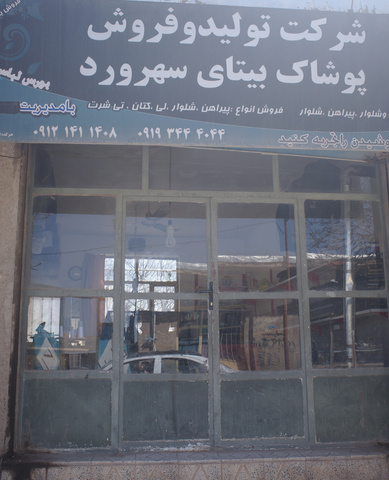
The tailor's shop of Mahmood's father
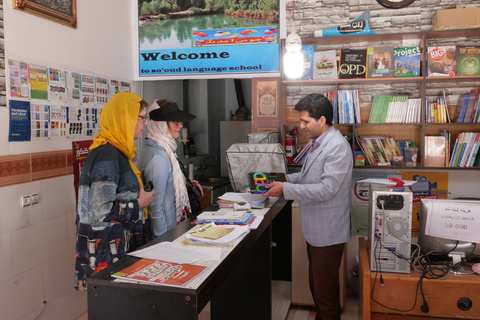
Mahmood shows us his language school
Then we walk to the town center, where we see the sculpture of a big fruit bowl as landmark, and a sculpture of Shihabuddin Yahya Suhrawardi.
Town place with the big fruit bowl
Suhrawardi's sculpture
In the meantime it has become afternoon. And we are invited into the house of Mahmood's uncle Ali Bahrammi for a short rest. Ali and Mahmood are here running a small guesthouse. Everybody is welcome here, especially those interested in the heritage of the great philosopher (contact: m.eshragh71@gmail.com). We are offered a delicious snack with home made cheese, flatbread, honey and fresh herbs.
Delicious snack at uncle Ali Bahrammi
Now the fish are prepared for the barbecue, and the picnic baskets ready. In the late afternoon sun we walk through the gardens, until we reach the right lot.
Walking through the gardens
Uncle Ali is the barbecue master. After having lit the fire, he puts the tea pot on it. We learn that real fire tea is tasting best. Ali teaches his younger son how to prepare the fish for the barbecue, while the other children are playing and swinging. Now the barbecue is sizzling above the fire, and the meal can start.
Ali's wife has accompanied us too. But she is shy and doesn't want that we take pictures from her for public use. We respect this of course. And I give her my prayer beads, which are made of agate and silver. I had bought them at the bazaar in Istanbul. And she seems very happy with it.

Ali shows his youngest son, how it works

Mahmoods daughter on the swing with Ali

A quick group photo before the serving: (from left to right) Mahmood with his daughter and Ali's son, our driver, Dieter, Daniela, Ingrid
Finally we drive to the other side of the valley. It offers a good view to Sohrevard. And there is a tomb of one of the descendants of Hussein. Slowly dusk is settling down on the landscape, and we say farewell to our new friends.
The mausoleum with the descendant of Hussein

The children are more interested in walking on the wall

A last view on Sohrevard in the evening light
Expel empty melancholy from your head
diminish your pride
and increase in neediness.
Your master is love:
when you reach her
she will tell you
with the tongue of ecstasy
how to act.
Shihabuddin Yahya Suhrawardi, “On the Reality of Love”

